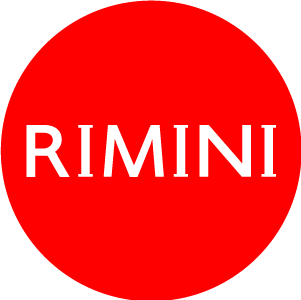A new area of the Fellini Museum, dedicated to information, study and research, opened to the public above Cinema Fulgor on 12th December 2021
With its entrance on Piazzetta San Martino, the Palazzo Fulgor, whose ground floor houses the most famous cinema in the world, the Fulgor Cinema, has been dedicated to information, study and research.
Fellini’s imaginary world exists naturally in his films, reflected in the original posters and fliers which are kept in the hall on the first floor; but it is also still alive in the documents, both text and pictures, which describe the relationships, the dreams and the projects which nourished his work.
On the first floor visitors can take their first steps, using the digital archive, through the large range of drawings, letters and first-hand accounts that make up the Fondo Federico Fellini collection owned by the City of Rimini. The digitalised material can be explored and examined here, while some of the original versions are also on display in in the rooms of the same building, or in Castel Sismondo.
On the second floor, in the Stanza delle Parole (Talking Room) you can hear Fellini in his own intimate voice, a key and distinctive trait behind the legend. Fellini’s sensitivity to the quality of voices and sound also shines through in the luminous plasma screen in the Casa del Mago (Wizard’s House), where we find the director asking for help from the occult and looking for mystical contributions to increase the range of his poetic work. In the Cinemino (Little Cinema) you can see the entirety of his work and understand the extent of his importance at a global level, while the Convivio (Banquet) is an area with a cinematographic stamp in which to develop knowledge of Fellini. It is a convivial area, with the document cabinets taking us through the life, the work and the friendships of Fellini and Moviola editing stations enabling visitors to re-edit some clips of films by the director from Rimini. The contents are accessed in a way that suggests classic film editing machines and creates a direct and playful experience of the Fellini universe.
Other Fellinian visions follow one another on the third floor of the Palazzo del Fulgor. Invented well before film, the magic lantern has appealed to popular imagination, creating emotions and a culture which is grandiosely recreated by Fellini in his “Casanova”: in the belly of the she-whale, where Casanova meets the giantess, a magic lantern projects images and drawings of female bodies. The lantern show is to be seen in a historical perspective which explores the debt that filmmakers felt to this forerunner of theirs: for Fellini, the magic lantern show is one that can open up a receptiveness to wonders and an opening to interiorising the archetypal images which would later be developed by filmmakers. A cloud of experiences, feelings and stories come out as the outlines of an extensive collective mythology, until it licks the heavenly horizon that we see in the fascinating Fellinian sky, with the twelve constellations that recall, once more, Fellini’s passion for the divinatory, the prophetic and the occult. We find more magic in the Altane (turrets): projected onto the Cinemino and the Casa del Mago below, we can admire bewitching images and some of the best scenes of the great films made by the Rimini maestro.
The third floor is also furnished with a comfortable chairs, a bar area and some exhibition cabinets.
Welcoming visitors to Piazza San Martino, at the Fulgor Palace entrance is a large sculpture in jesmonite depicting the rhino protagonist of some of the most powerful and evocative scenes in Fellini's imaginative movie “E la nave va” (And the Ship Sails On), now the symbol of the entire museum centre. A lighter version of the rhino has taken the role of ambassador for the Fellini Museum by participating in a Grand Tour of Italy: at the beginning of September, "Rina" - as the rhino has been nicknamed by the media following her on all her travels - was in Venice for the Film Festival, where she took part in the Regata Storica parade on the Grand Canal and then landed on the red carpet of the Venice Lido. Afterwards, the rhino participated in the sixteenth edition of the Rome Film Festival, where until a few days ago she stood in the Hanging Gardens of the Parco della Musica Auditorium, in the green area between the Petrassi and Sinopoli halls. Now Rina is back in Rimini, in the splendid setting of the Grand Hotel garden.
Opening hours and period
Admission fee included in the Fellini Museum ticket.
Entrance fee only for the Palazzo del Fulgor: € 2.


